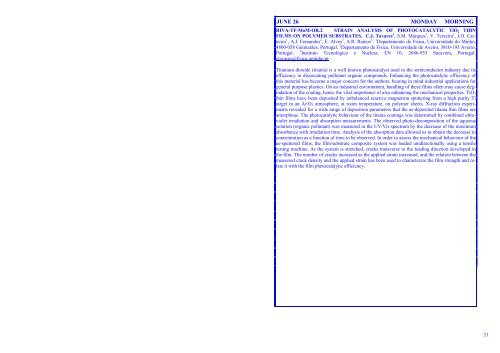Wüest M. 51 Wykes M. 82 Yamaguchi M. 17 Ybarra G. 129 Yubero F ...
Wüest M. 51 Wykes M. 82 Yamaguchi M. 17 Ybarra G. 129 Yubero F ...
Wüest M. 51 Wykes M. 82 Yamaguchi M. 17 Ybarra G. 129 Yubero F ...
You also want an ePaper? Increase the reach of your titles
YUMPU automatically turns print PDFs into web optimized ePapers that Google loves.
JUNE 26 MONDAY MORNING<br />
RIVA-TF-MoM-OR.2 STRAIN ANALYSIS OF PHOTOCATALYTIC TiO 2 THIN<br />
FILMS ON POLYMER SUBSTRATES. C.J. Tavares 1 , S.M. Marques 1 , V. Teixeira 1 , J.O. Carneiro<br />
1 , A.J. Fernandes 2 , E. Alves 3 , A.R. Ramos 3 . 1 Departamento de Física, Universidade do Minho,<br />
4800-058 Guimarães, Portugal. 2 Departamento de Física, Universidade de Aveiro, 3810-193 Aveiro,<br />
Portugal.<br />
3 Instituto Tecnológico e Nuclear, EN 10, 2686-953 Sacavém, Portugal.<br />
ctavares@fisica.uminho.pt<br />
Titanium dioxide (titania) is a well known photocatalyst used in the semiconductor industry due its<br />
efficiency in dissociating pollutant organic compounds. Enhancing the photocatalytic efficiency of<br />
this material has become a major concern for the authors, bearing in mind industrial applications for<br />
general purpose plastics. On an industrial environment, handling of these films often may cause degradation<br />
of the coating, hence the vital importance of also enhancing the mechanical properties. TiO 2<br />
thin films have been deposited by unbalanced reactive magnetron sputtering from a high purity Ti<br />
target in an Ar/O 2 atmosphere, at room temperature, on polymer sheets. X-ray diffraction experiments<br />
revealed for a wide range of deposition parameters that the as-deposited titania thin films are<br />
amorphous. The photocatalytic behaviour of the titania coatings was determined by combined ultraviolet<br />
irradiation and absorption measurements. The observed photo-decomposition of the aqueous<br />
solution (organic pollutant) was measured in the UV/Vis spectrum by the decrease of the maximum<br />
absorbance with irradiation time. Analysis of the absorption data allowed us to obtain the decrease in<br />
concentration as a function of time to be observed. In order to assess the mechanical behaviour of the<br />
as-sputtered films, the film/substrate composite system was loaded unidirectionally using a tensile<br />
testing machine. As the system is stretched, cracks transverse to the loading direction developed in<br />
the film. The number of cracks increased as the applied strain increased, and the relation between the<br />
measured crack density and the applied strain has been used to characterize the film strength and relate<br />
it with the film photocatalytic efficiency.<br />
21
















